Asparagus Cooking Guide
Shopping Tips | How to Store | Varieties | Cooking Tips | Recipes
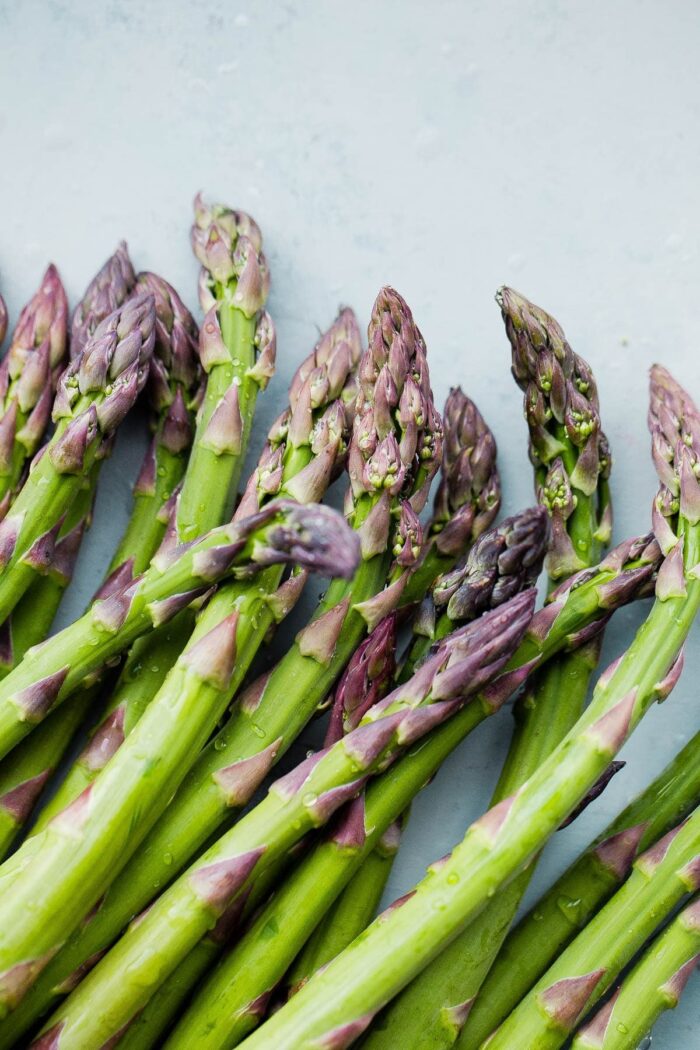
Asparagus season has arrived! We’re delving deep into my favorite spring vegetable: shopping tips, varieties, how to store asparagus, cooking tips and basics, and recipe ideas.
After picking up my first bunch of local asparagus the other day, I was reminded of one simple fact: nothing beats local, freshly picked asparagus.
Here are my best tips and tricks!
How to Pick Good Asparagus:
Asparagus season generally runs from March to early June. This is the period when you’re most likely to find local or regionally sourced asparagus (the best). It is short-lived season, so take advantage while it lasts!
Like most vegetables, asparagus loses moisture, flavor, antioxidants, and phytonutrients rapidly once picked. They are highest in natural sugar (flavor) when just picked. For this reason, it is cook it in season, source locally, and prepare it the day (or day after) it is purchased.
Look for firm, straight stalks with tightly closed spears and smooth, colorful (not woody or white) ends. Avoid mushy, bruised, or dry, brittle spears. If a produce display has bunches sitting in a shallow pool of water, check those first as they can tend to be in better shape.
Asparagus stalk thickness is not an indication of quality or maturity, but related to the age/sex of the plant. For basic cooking, I generally prepare asparagus differently depending on stalk thickness (see cooking tips below).
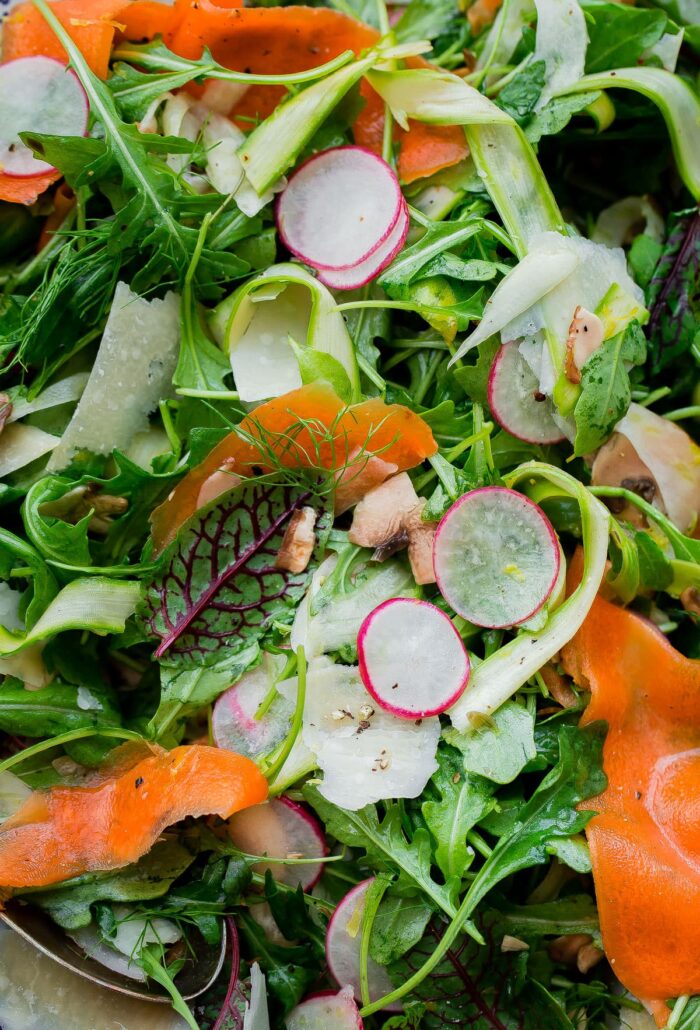
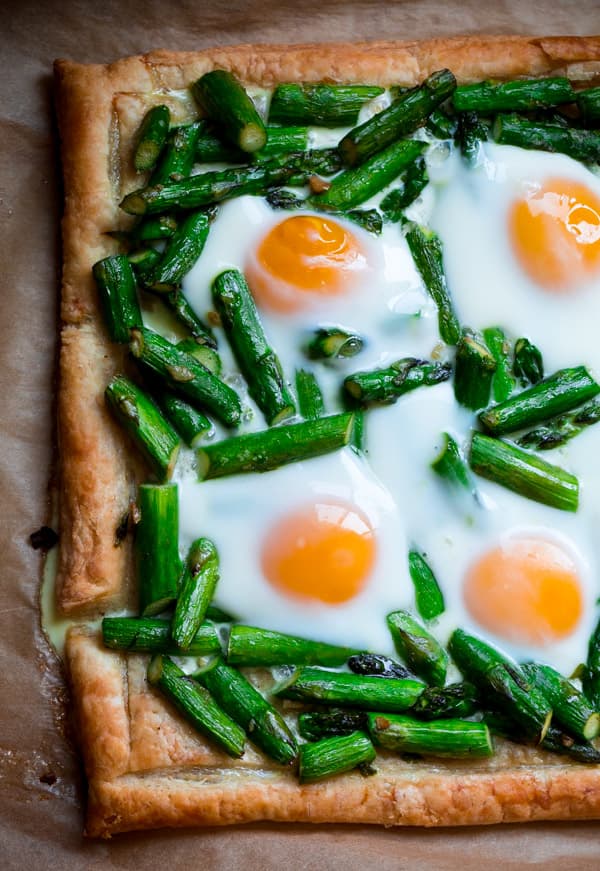
How to Store Asparagus
Remove any rubber bands and wrap the ends of the asparagus stalks in a lightly damp kitchen linen, place in a perforated or Ziplock bag, and store in the produce drawer in your refrigerator. Alternatively, store the asparagus stalks, spears facing up, in a wide mouthed jar filled with 1-inch of water – similar to a flower arrangement.
Use asparagus within a day or two of purchasing. Do not rinse or wash the stalks until just before using. Gently bend the spears to snap and discard any tough ends, or use a knife to trim them (if fibrous, you can also peel the ends of the stalks with a vegetable peeler).
Once picked, asparagus loses natural sugars and nutrients extremely quickly. As time passes, the ends of asparagus stalks become tough and fibrous in texture. This requires more trimming and waste (ie. cost per pound). Wrinkled and tough stalks provide clues as to when the asparagus was harvested (likely not recently).
Try to source locally grown and in-season asparagus only. They come at a higher cost, but the quality, freshness, and flavor is unparalleled.
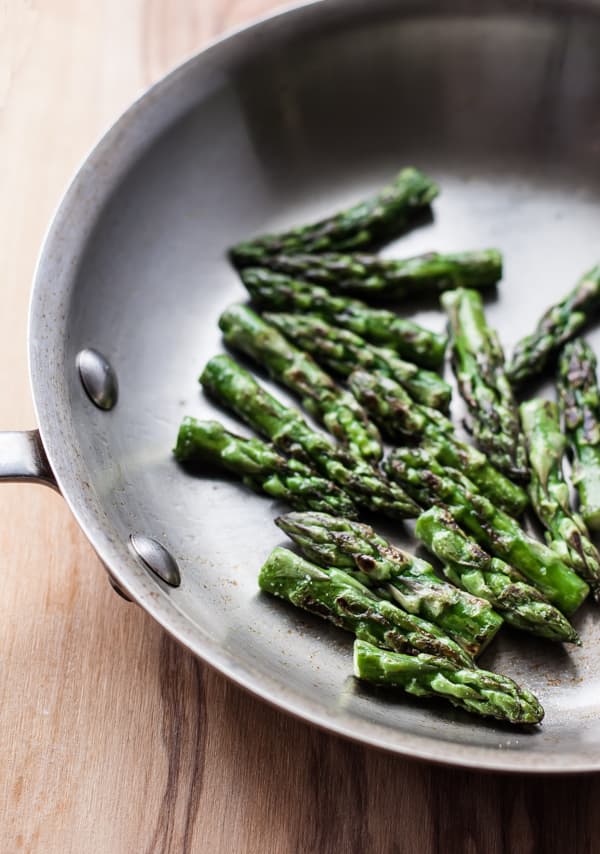
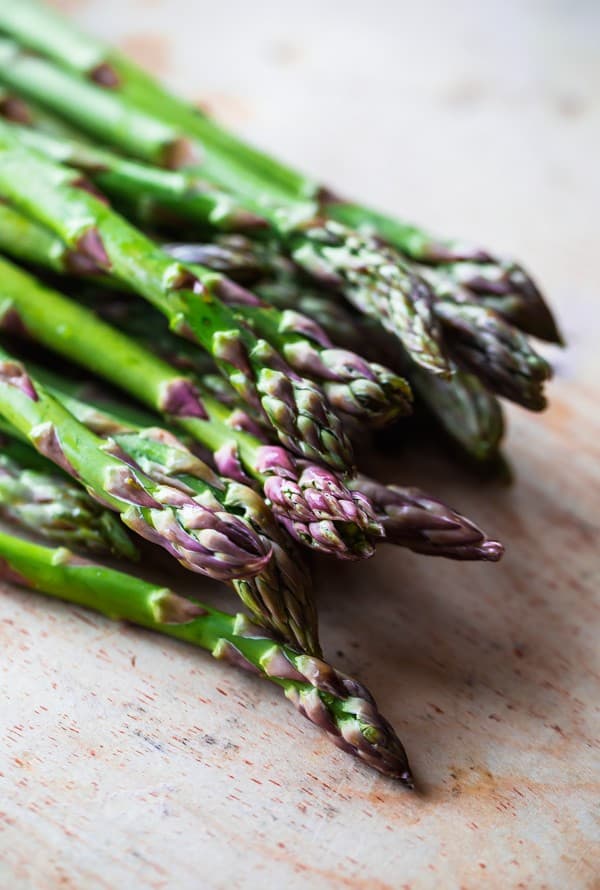
Types of Asparagus:
While they can be hard to find outside local farmer’s markets, there are lots of asparagus varieties that range in color from dark green to deep purple.
Green asparagus is the most commonly available asparagus, but comes in different varieties. If you find green asparagus with dark purple spears (see photo below), get them. They are most likely grown local to your area and are absolutely fantastic.
Purple asparagus is milder in flavor than green asparagus, yet contains three times the antioxidants as most green varieties. They lose their dark purple hue when exposed to lots of heat or water, so opt for raw preparations or a quick sear on the grill.
White asparagus (not a separate variety/species) are picked just as the spears begin to emerge from the ground – or alternatively, covered with mounds of soil during farming. Since they aren’t exposed to sunlight, they do not produce chlorophyll. White asparagus are mild in flavor and lower in nutrients. They are very popular in European and French cuisine.

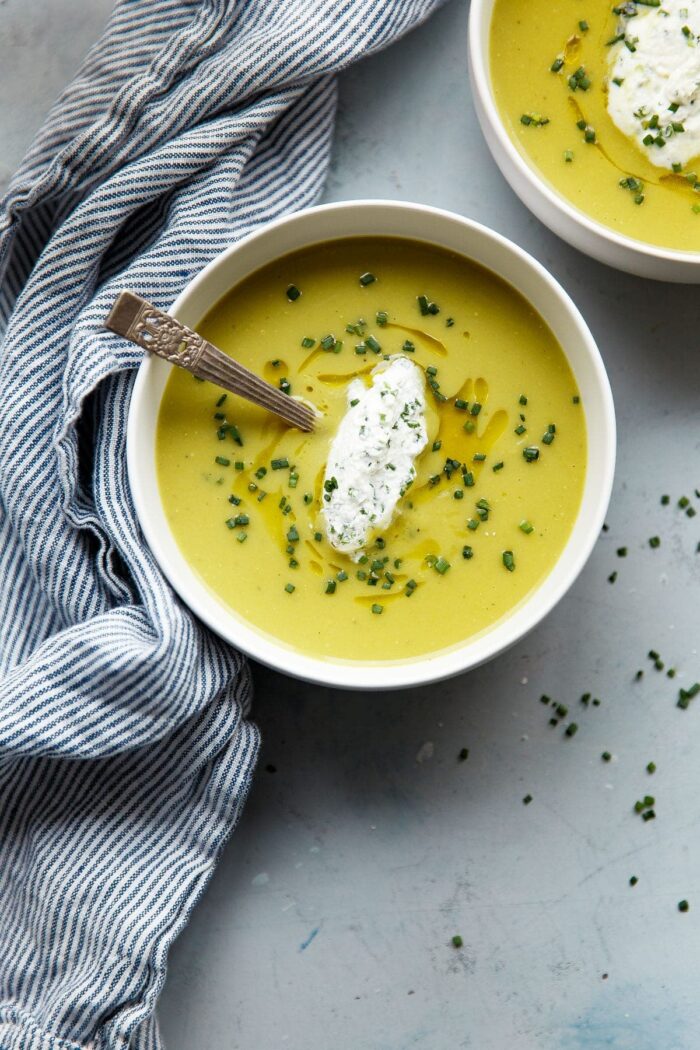
How to Cook Asparagus:
While steamed asparagus is higher in antioxidants than raw asparagus, my favorite way to prepare asparagus is to toss the stalks with olive oil, seasoning, and toss on the grill or roast in a hot oven (425°-450°F /220°-230°C).
If the stalks are thin and delicate, chop or slice on a bias into 1 to 2-inch pieces. Heat oil in a wok or skillet and sauté over medium-high heat until fork tender.
Thick asparagus is best suited for grilling (longer cooking time and less likely to fall between grates), steaming or blanching, using in Asparagus Soup, or shaving into ribbons and using raw in dishes like this Shaved Vegetable Salad.
Alternatively, a quick blanch in boiling water followed by an ice bath, as demonstrated in this Asparagus and Goat Cheese Quiche, helps to preserve asparagus’ vibrant green color.
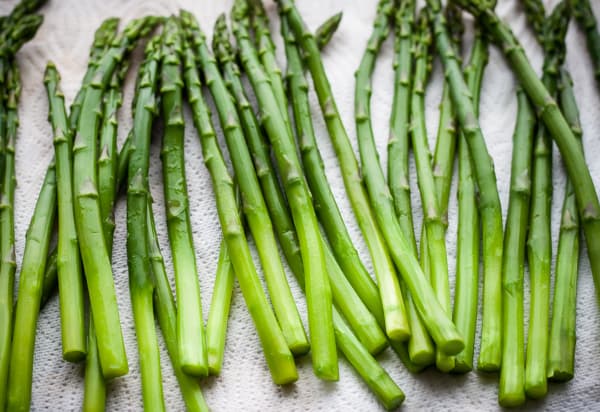
Quick Cook Tip: If preparing a spring pasta, drop chopped asparagus into the salted water just as the pasta is finishing cooking as a quick way for add fresh vegetables to a dish.

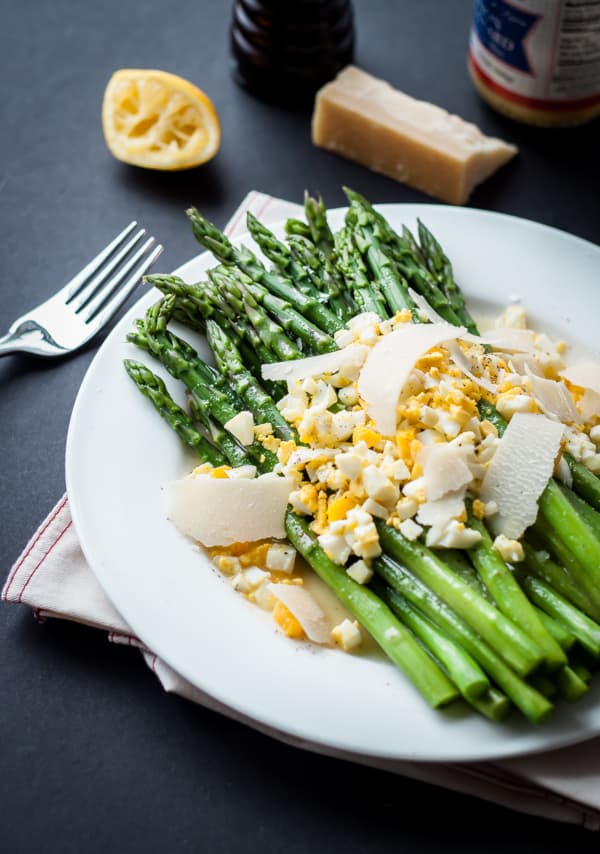
Flavor Pairings and Recipes
Asparagus is relatively delicate in flavor, but pairs particularly well with the following: eggs, cheese (parmigiano-reggiano), lemon and other citrus, garlic, tarragon, mushrooms, and balsamic vinegar.
Here are a few of my favorite asparagus recipes:
Resources:
- Eating on the Wild Side: The Missing Link to Optimum Health by Jo Robinson
- The Flavor Bible + The Vegetarian Flavor Bible by Karen Page and Andrew Domenburg
- On Food and Cooking: The Science and Lore of the Kitchen by Harold McGee
- The Chef’s Garden by Farmer Lee Jones and Kristin Donnelly

7 Comments on “Asparagus Cooking Guide”
Super informative and helpful.
Asparagus is one of my faves!! I usually just roast it with olive oil and salt and pepper, too (sometimes soy sauce!), but the other day I roasted it with a little parmesan cheese and it was sooo delicious!
Must be veggie week! We just posted about how to shop and prep for an hour or so to be able to have healthy, less effort meals all week. A week of asparagus sounds so good!-Laurel
I love your ingredient spotlights as well! I totally agree that the farmers market asparagus that is fresh has Much better flavor, and is worth the extra price.
Thank you so much Alison! I totally agree. Also, I tend to never waste any of it (minimal to no trimming), so I think it’s actually a better value in the end. ?
Okay, I love this!! Can’t wait to see more ingredient spotlights – I love learning about this kind of thing. Asparagus is one of my favorite veggies, nothing beats it roasted!
Yay! So glad you enjoyed it Lucia!! 🙂 Thanks for the feedback!